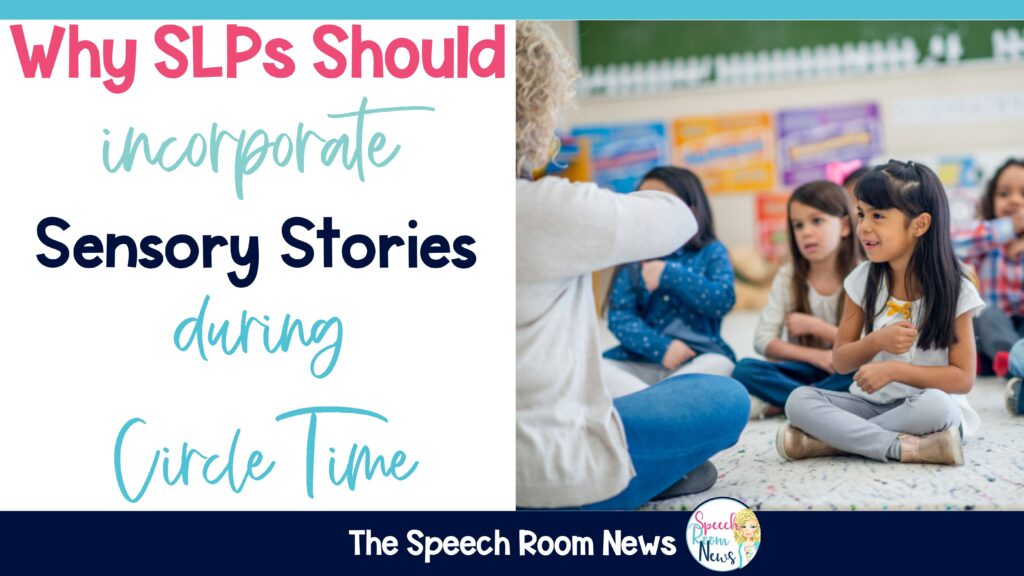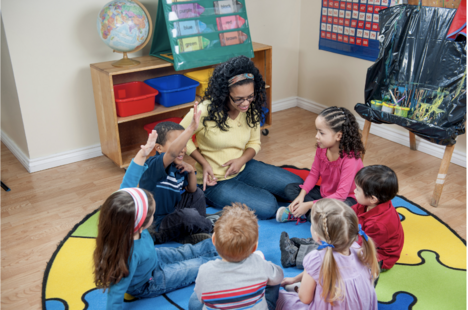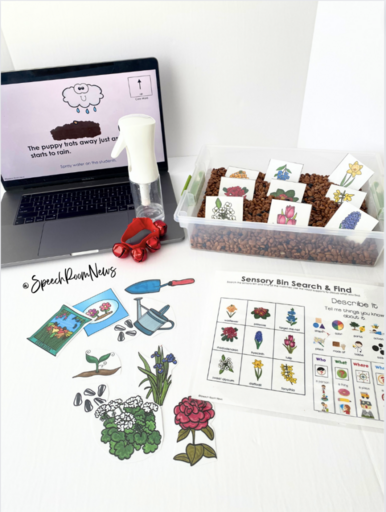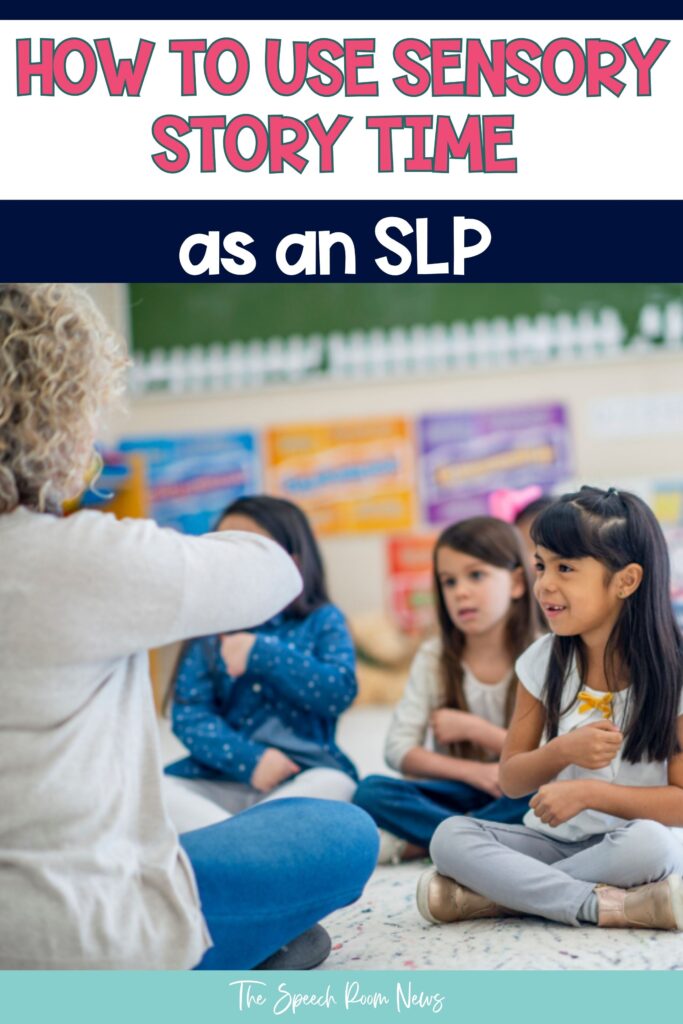As speech-language pathologists, we are constantly seeking innovative and effective ways to engage children who struggle with their speech and language skills. One technique that holds promise for school-based SLPs is the use of sensory story time. Using fun stories, combined with sensory experiences, provide a powerful tool for fostering language development, communication and overall engagement.
Stories have the extraordinary ability to transport us to different worlds, ignite our imagination, and evoke emotions. They capture our attention through words, but what if we could go beyond auditory involvement and engage all of our senses in the storytelling experience? Enter sensory stories—a fun way of conveying narratives by integrating text with complimentary sensory experiences. I love to do a sensory story time for push-in therapy during circle time in the early childhood grades. Let me explain why sensory stories are perfect to use to work on speech and language goals.
What is a Sensory Story Time?
In a sensory story, each section of the story is condensed into short, concise sentences. But what makes them really engaging for children is the accompanying sensory stimuli that help bring the story to life. So if you are reading a story about a boat sailing across the sea, then water is lightly misted using a spray bottle to create the sensation of being on the voyage in the story. By incorporating touch, smell, sound, taste, and visual stimuli, sensory stories engage all of the senses, creating a rich and immersive experience for the learner. I loved doing sensory story time during a circle time in a preschool or kindergarten classroom if I was doing push in therapy. However, you could definitely use sensory stories in your small groups or with one on one students as well.
Sensory Story Time Benefits
Sensory stories are not only enjoyable but also have significant educational benefits. They help make children want to engage with the story and get excited about it. In addition to auditory involvement, sensory stories provide ways for students to develop various skills such as memory, communication, vocabulary, social interaction, literacy and movement. Pick key themes, words, and experiences that will resonate with your students so you can make the story more meaningful and engaging to them. Plus, kids just love sensory stories because they are FUN!
Integrating sensory stories into therapy sessions offers many benefits for children struggling with speech and language skills. First, it promotes active participation and engagement, as these sensory experiences really spark their curiosity and also engage them to participate and listen. Additionally, sensory stories provide a context for language-rich interactions, encouraging vocabulary development, expressive language practice and narrative skills. Using sensory stories with children also helps them to make meaningful connections between words. This is exactly why using sensory stories is so beneficial for our speech and language students.
Why Sensory Activities are Important for Speech & Language
If you’ve been around the blog for awhile, you know by now how important sensory activities are in my opinion. I incorporate sensory activities into speech anytime that I can really. By tapping into the power of the senses, educators and therapists can create an enriching and effective learning environment for our students. Let’s look at some reasons that sensory activities are so important:
- They engage multiple senses, which provides a more meaningful connection to learning.
- Many students, especially those with speech and language difficulties, may struggle with attention and engagement. Sensory activities capture their interest.
- Sensory experiences enhance memory retention and facilitates better recall of language concepts and vocabulary.
- Sensory activities provide a natural context for language-rich interactions. They offer opportunities for students to express themselves, describe sensory experiences, ask questions, make connections and engage in meaningful conversations.
- While some students excel in auditory learning, others may benefit from visual or tactile experiences.
- Sensory activities often promote self-regulation skills as students learn to manage their responses to sensory stimuli and develop strategies for staying focused and engaged.
Sensory Storytime Guidelines
When it comes to using sensory activities during story time, there are a couple of fundamental guidelines to keep in mind. First and foremost, ensure that each learner, regardless of their sensory abilities, has an active role in the sensory storytelling process. This active involvement enhances their engagement and personal connection with the story. Additionally, repetition plays a crucial role in multi-sensory storytelling. It is recommended to repeat the sensory story multiple times to build anticipation and familiarity. This repetition aids in reinforcing learning, establishing familiarity with the narrative and deepening the overall experience. If time, we would typically read the story two or three times during circle time when I pushed in to my preschool classroom.
Sensory Storytime Example
Here’s an example of a sensory story you can use right now. Imagine that a child on your caseload is working on vocabulary and expressive language skills and you want to relate this to flowers because this little girl loves flowers. By incorporating sensory stories, you can transport them to a garden filled with blossoming flowers. You can make each sentence in the story come alive through the integration of sensory experiences, such as touching petals, smelling fragrant scents, listening to the rustle of leaves, and observing colorful visuals.
You can use this Flowers Kit for SLPs for push-in therapy. It includes one full month of lesson plans including therapy printables, interactive play resources, 4 circle time lessons, parent handouts and books companions. In this kit, there are songs, chants, finger plays and even YouTube links for music related to flowers. Plus there are even three different sensory bins you can use with students as a follow-up activity during small group speech therapy.
The Flowers Kit focuses on one fiction and one nonfiction story. The fictional text is “Planting a Rainbow” by Lois Ehlert. The nonfiction text is “I Can Grow a Flower” by DK Books. There is a prep cheat sheet with these lessons that will tell you everything that you need to make this story come to life. For example, on one page of the story, it says that is starts to rain and it guides you to use the spray bottle to spray water on the students.
GRAB THE SENSORY STORY FLOWER KIT HERE!
Other Resources about Sensory Story Time
Download Sensory Story Circle Times included in my Theme Therapy Kits
More Sensory Activities to Try During Speech Therapy
7 Speech Skills to Target with a Little Blue Truck Sensory Bin
“Too Many Carrots” Sensory Bin
How to Use Sensory Bins in Speech Therapy and Taste-Safe Fillers
The Three Little Pigs Sensory Bin
Beach Hunt: Interactive Sensory Tub
Do you use sensory activities during speech therapy?
Join the SRN newsletter!

I'm so glad you stopped by! If you'd like to keep up with the newest posts and get exclusive free downloads, please sign up for the newsletter! Your first freebie is ready as soon as you subscribe and confirm your email!






Thank you for including a link to my Sensory Story page, it is much appreciated.
I’m new to learning strategies for fostering language development, so I found reading this blog very insightful. I think it’s a great idea to use sensory stories for pull-in classrooms and for any class in general. By adding in sensory elements to stories, it allows students to be actively engaged in the reading. Students with speech and language impairments may struggle with attention during language-rich interactions, so being able to use all their senses offers them multiple ways to make meaningful connections. Sensory stories offer opportunities for students to express themselves, describe sensory experiences, ask questions, and engage in meaningful conversations. These experiences also enhance memory retention and better recall of language concepts and vocabulary. Very informative and a great read!